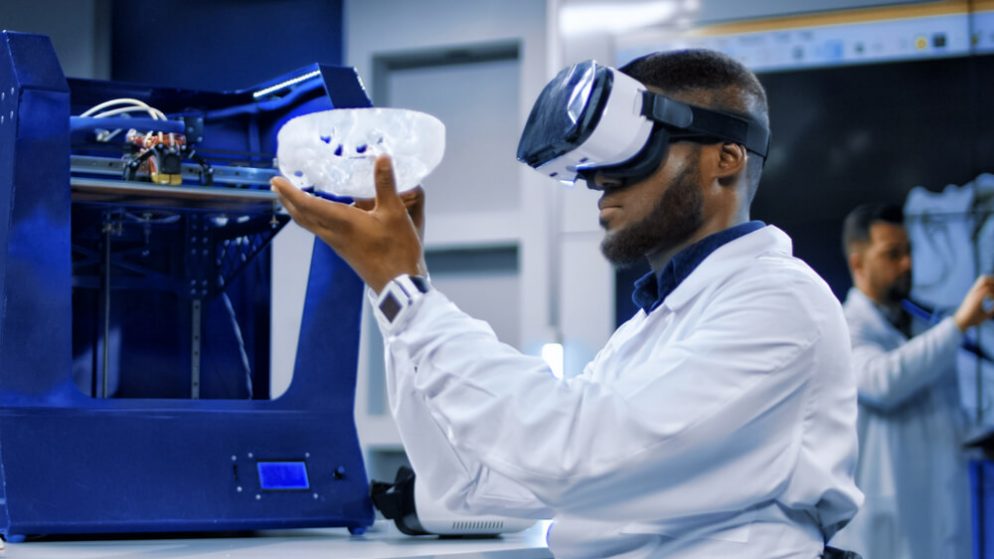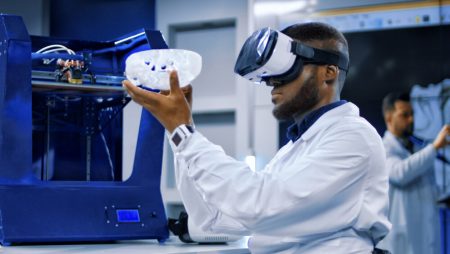



Get new exclusive access to healthcare business reports & breaking news




There’s no denying the health care industry is constantly evolving — whether it’s adopting new technologies or creating innovative treatment options.
One piece of technology that could serve as a significant disruption to the industry is 3D printing. It’s come a long way since its introduction over 30 years ago, and the advantages of utilizing it are plenty. For example, 3D printing is capable of improving existing surgical procedures and can assist with organ transplantation.
The average 3D printer can cost anywhere from $5,000 to $50,000, depending on how complex the machine is. The more expensive a 3D printer is, the more capabilities it has and more can be accomplished when using it.
3D printing has taken various industries by storm, from manufacturing to architecture. More sectors recognize the benefits of using 3D printers to fabricate different objects needed in their respective fields.
One of the primary advantages of using 3D printing technology is the potential cost-savings outlook. While it is expensive upfront, evidence suggests leveraging it in internal operations can lead to long-term savings. That makes it a viable option for medical professionals.
Below is more information regarding 3D printing in the medical field and how the revolutionary technology reduces health care institutions’ costs.
By 2028, it’s estimated that the 3D bioprinting market size will surpass $4.3 billion with a compound annual growth rate of 15.5%. One of the main contributing factors to this expansion is 3D printing in cosmetics, health care and pharmaceutical applications.
Recent evidence suggests an increasing demand for organ transplantation, which is yet another driver behind this market growth. 3D bioprinting can serve as a feasible solution for overcoming the challenges of organ transplantation.
For example, the University of Arizona received a $2 million grant to heal bone fractures using 3D printing technology. The grant covered expenses of using adult stem cells, which is also a growing trend in the medical field. In this case, one of the benefits of 3D printing is to reduce suffering in the patient and improve their quality of life.
Over 100,000 men, women and children are currently on the waiting list for organ transplants. With the help of 3D printing technology, that number could potentially decrease and allow more people in need of artificial organs to receive care.
A light was shone on the 3D bioprinting market during the height of the COVID-19 pandemic, as a shortage of personal protective equipment (PPE) caused hospitals and health care facilities to rely on 3D printed masks, face shields and other medical devices.
3D printing became essential, as some private companies stepped up and began producing critical PPE for those on the frontlines of fighting this virus.
It’s no wonder that 3D printing is more than just an industry trend — the technology has the power to truly transform the industry for the better. However, because of the expensive nature of the technology, it can present some challenges to health care professionals.
One example of how 3D printing can achieve lower costs is that the technology tends to use less energy than traditional manufacturing processes.
According to a study from Michigan Technology University, researchers discovered that 3D printed objects consume 41%-74% less energy than other large-scale manufactured goods.
While the survey tested solar-powered 3D printers, even those running off nonrenewable electricity still had a cost savings of 64%.
It’s clear that energy efficiency is something every industry is trying to achieve, whether it’s health care, retail or manufacturing.
Because 3D printers are somewhat energy efficient, no health care professional can deny the benefits of using them in their operations. Medical facilities tend to use vast amounts of energy, so identifying every avenue for efficiency is necessary.
For example, hospitals can achieve energy efficiency by replacing light fixtures with LED bulbs. Using data analytics to identify more areas for improvement is another method health care institutions should consider implementing.
3D printing can contribute to cost savings when it comes to creating prosthetics. Because there are nearly 2 million people in the U.S. with amputations, the role of 3D printing in prosthetic creation is a significant one.
3D printers can produce perfect-fitting prosthetic parts that can improve the quality of life for someone with an amputation, as it helps enhance their mobility.
3D printing technology lowers the cost of prosthetics, making it more accessible for those with amputations. The average price of an advanced prosthetic limb can cost anywhere from $5,000 to $50,000. By investing in 3D printing, hospitals can achieve cost reductions in the long run.
It’s no surprise that the health care industry sometimes runs into issues of surgical instrument shortages. Thankfully, 3D-printed versions can be produced, thus saving on traditional shipping costs and combating the risk of running out of necessary equipment.
The average cost of surgical instruments is over $3,500. Leveraging 3D printing tech could drastically reduce that number and improve operational efficiency in a surgery room.
There are hundreds of 3D printing applications in the medical field, and more applications will emerge as the technology continues to develop and improve.
One study listed in the National Library of Medicine examined the cost-effectiveness of using 3D printed tech in surgeries. The study examines how 3D-printed models and surgical guides can potentially save on costs for health care facilities. Reducing time in the operating room is critical for the patient themselves as well as the surgeons performing an operation.
In the study, seven surgeries that used 3D-printed anatomical models ended up demonstrating a mean of $62 per operating minute, with a range of $22-$133 per minute. The amount of time saved means more surgeries can be performed in the same amount of time. It’s evident that 3D-printed tech can improve costs with this method.
More specifically, the research shows that creating 63 3D-printed models or guides a year would be able to cover the operating costs needed to adequately maintain an in-house printing lab. It’s clear that this kind of technology pays for itself in the long term.
Aside from prosthetic limbs and being energy-efficient, 3D printers offer a wide variety of applications in the medical field. Below are some other common uses for the revolutionary technology.
Researchers at Harvard University used a custom-built 3D printer and dissolving ink to create a swatch of tissue that acts as blood vessels in a human. This could be transformative for tissue repair and regenerative medicine, as the material can be embedded into a patient’s skin and perform the same functions as a traditional blood vessel.
A 3D printer was used to produce a mold for human ears and noses needed in various medical procedures. For example, the mold of a human ear is filled with a gel made of bovine cartilage cells, which helps maintain its shape. They look just like the real thing and can be used on skin cancer patients.
Researchers from the University of Minnesota were able to 3D print a lifelike replica of a human aortic heart valve. This tech can improve patient outcomes, and the procedures to implant the models are minimally invasive.
3D printing a valve specifically made for a particular patient can help reduce medical risks during surgery, as complications are common during these procedures.
Fluicell, a life science company built on innovation, is currently working on creating a viable treatment option for Type 1 Diabetes. Its internal research team is in the early stages of creating a medicinal product that could potentially treat the disease with no cure.
The team uses Biopixlar high-res 3D printing technology to produce biocomposites that can mimic the insulin-producing function of the pancreas. The results so far look promising, so it’s only a matter of time and money until this type of 3D printing technology can offer a solution to Type 1 Diabetes treatment.
While some of the examples listed above focus on more extreme medical cases, there are also plenty of applications for 3D printing in mainstream medical care.
For example, Harvard Business Review shared that 3D-printed ankle replacements, casts and even 3D-printed pills are making their way into the health care industry. Believe it or not, 3D printed casts actually heal bones 40-80% faster compared to traditional casts, which leads to improve patient outcomes.
While there’s a current lack of research on the cost-saving possibilities of these applications, more research will likely emerge to show how viable these technologies are in the medical field.
More medical technologies, such as the Internet of Medical Things (IoMT) and artificial intelligence (AI), are other examples of tech that could improve the existing health care system in various ways. It’ll be interesting to see the significant role 3D printing plays in the future of health care.